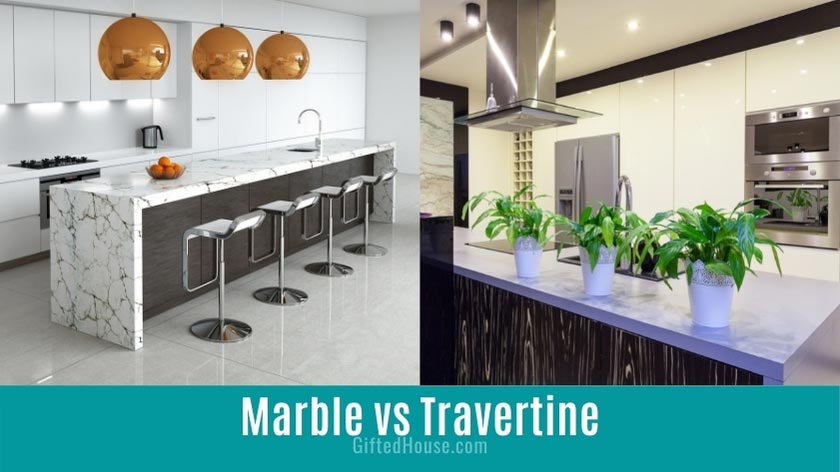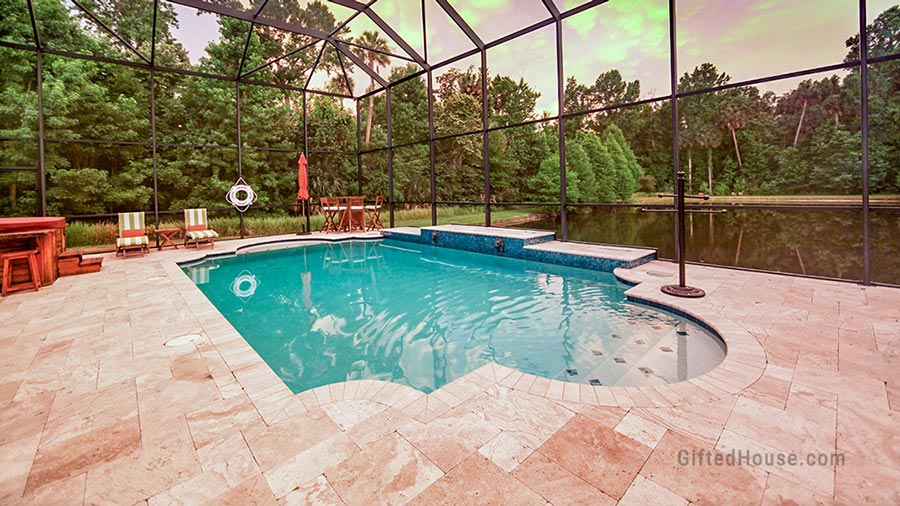Are you stuck between choosing marble or travertine for your countertop, pool deck, or floor?
Perhaps you thought marble and travertine were the same stone? After all, plenty of people do. Travertine and marble belong to the limestone family and many homeowners use the stones interchangeably, without considering their different pros and cons.
This article will look through the differences between marble and travertine and find out which is most suitable for your home renovation needs.
Differences Between Marble and Travertine?
The critical difference between marble and travertine lies in their appearance and their formation. They also differ in hardness, cost, and durability. Travertine, with a hardness of 4-5 on Mohs Hardness Scale is more scratch-resistant than marble which has a hardness of 3-4.
Let’s take an in-depth look at the differences.
Appearance
While they both look stylish and elegant, these stones have their own unique appearance.
Marble
A recognizable characteristic of marble is its unique veining. The veining on marble can be minimal or distinct, and both are beautiful. Sometimes marble can be one solid color with no veins, although this is a rarer style.
What’s excellent about marble is the multitude of colors it comes in. Depending on your room’s color scheme, you could opt for a cool gray, deep black, or rich brown. Colors like pink, green or blue are also available.
Another distinct characteristic of this material is its smooth texture. Manufacturers can finish marble with a polished, glossy appearance or a beautiful satin finish.
Travertine
Contrary to the luxurious appearance of marble, travertine offers a more earthy elegance, which is also popular with the homeowner. Travertine is noticeably porous, which gives the material a more textured and rustic appearance.
It is, however, possible to sand down and seal it to make the material more smooth. You can buy this material in various finishes such as polished, honed, or tumbled.
Travertine is available in warm colors like cream, beige, brown, and red. Although travertine lacks the veins that make marble unique, travertine does have slight variations in the shade and pattern between tiles. Flooring enthusiasts will also be happy to know that both materials develop a patina over time.
Formation
How are able and travertine formed in nature?
Both travertine and marble are part of the limestone family and are created from sedimentary material, but that’s where the similarities in their formation end.
Marble begins as limestone before transforming over time into marble because of high levels of pressure and temperature.
Travertine is formed through heat and pressure applied by the earth’s crust in hot springs and limestone caves. The ejection of hot water and gases during this process also creates minuscule holes in the travertine, which gives the material its natural, earthy appearance.
Durability
Marble and travertine both have excellent durability. They can withstand everyday use and are perfect for high-traffic areas.
Do they need to be sealed?
Both marble and travertine are porous, so you must seal them. Sealing the marble or travertine will ensure the stone remains free of scratches.
Do they stain?
The porosity of both materials means they’re prone to stains. These materials are highly reactive to acid, so you must clean any spillages immediately to avoid stains.
Do they get scratched?
While these two materials are hard stones, they’re softer than other natural stones like granite. This doesn’t detract from their durability as they’re harder than most non-stone materials. It does, however, mean they can easily scratch if you don’t seal them properly.
Cost
The quality of either stone will affect the price of the purchase. In general, the natural types of both travertine and marble will cost more.
A quick outline:
- Most Expensive: Natural Marble
- 2nd most Expensive: Natural Travertine
- 3rd in cost-wise: Cultured Marble
- Least Expensive: Cultured Travertine
The cost of marble and travertine can range from $2 to $50 or more per square foot, depending on the type.
Installing the Stone
Marble and travertine can both be difficult to install depending on the thickness of the slab and the stone’s quality. The more challenging the installation, the more expensive it will be.
Popularity
Marble has a long history of popularity. Many regard the stone to be the pinnacle of luxury and affluence. It has been used in many grand buildings like the Taj Mahal. It’s a timeless material that you’re guaranteed to find in many high-end buildings.
Travertine is also popular but for different reasons; it is accessible and easy to work with. It works well in indoor and outdoor spaces and is available in various sizes, patterns, and finishes, making it a versatile option. Travertine brings a lot of warmth to a room, which makes it popular in modern family homes.
Travertine or Marble Which Is Better?
For Flooring
If you’re looking for indoor flooring, marble is your best option. Travertine has more pores, whereas marble has a smoother texture that makes it more suited for the interior of your house.
Countertop
Both materials are attractive options for your countertop and give an elegant look to your kitchen or bathroom.
Marble with its unique design patterns gives you a luxury look. However, if you want to brighten your kitchen, travertine is an excellent option as it’s brilliant at reflecting light.
Pool Deck
The area around a pool needs to be non-slippery and resistant to factors like water, chemicals, and the weather. For this, travertine is the best option.
Not only is travertine durable, but it’s also non-slippery, and when sealed, it’s resistant to water and other factors.
Pavers
For pavers, travertine is the way to go.
Travertine absorbs water quickly, which makes it well suited to use around areas like pools. It also isn’t slippery and is soft to walk on, making it the optimal choice for driveways, entryways, and walkways.
You must know how to clean travertine as it requires more care than other materials.
Something to also keep in mind is that it could get damaged by heavy objects, but you can prevent this by using soft coasters.



